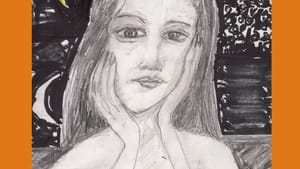Stay in the Loop
BSR publishes on a weekly schedule, with an email newsletter every Wednesday and Thursday morning. There’s no paywall, and subscribing is always free.
Beneath the burden of truth lies the questions of art
Questions of truth and identity

We seek truth in many things and absolute truth when someone has done wrong.
“Who did it?” is the first question asked after a crime, followed by “how” and “why”: identity, causality, and motive.
Identification is a strange thing. It is a paradox of revelation and limitation, seeking to enlighten only to cast the identified into a conceptual box — a thing with its particulars removed to fit into a universal. For most, this is not totally destructive, since we live multiple identities, changing them with the fluidity of daily existence: artist, mother, wife, BSR writer, prison volunteer, friend, and so on.
However, in crime, once who, how, and why have been determined through the legal process, and who has been incarcerated, the prison structure maintains the determined truth through its insistence upon a single identity for the prisoner. The prisoner is an inmate 24-7. When I ask prisoners if they ever think of themselves not as inmates, the most common answer is, “When I am sleeping.”
Who knows what?
This determined truth is further controlled by limiting any information. As a volunteer prison art teacher, it is illegal for me to ask who, how, and why regarding my students’ crimes. Likewise, it is forbidden for me to know the personal details of students’ lives and to share my personal information with them. This could essentially limit the exchange of personal information between a volunteer and prisoner to each person’s last name and the DIN number of the prisoner.
But legality is often a moot point in prison, where the disclosure of information is based upon power and not rights. So while I cannot ask, guards often describe the details of a crime despite the prisoners’ rights of confidentiality: “Did you know that inmate X threw his wife off a cliff; inmate Y torched his victim and watched him burn to death; inmate Z murdered and raped three women?”
That the guards taunt me with crime details of my students is understandable. Beneath this antagonism, the guards are asking a valid question: Can I feel positive toward prisoners when I know the extent of their crimes? Can I reconcile the paradox between a violent crime and the accused who may be a very good student? For some reason, I am not concerned with these contradictory dynamics. I usually know the crimes of my students. It seems as though ignoring that part of the student’s life is a different kind of identity control.
“I used to be a normal guy”
Ironically, the first prisoner I met in any prison is an artist who received his MFA from the same art school I attended. Joe [not his name] was in art school at the same time that I was, but I didn’t know him until teaching in prison. Years after that meeting, I explained our connection to a staff person, who suggested I not tell anyone else.
Joe is serving a life sentence. He accepts responsibility for his crime with a forthrightness that was probably a factor in getting that sentence. He says, though, that one person asked him about it in a way that gets at his own understanding: Instead of asking, “What did you do?” the person asked, “What happened to you?” For Joe, this best describes his experience because “I used to be just a real normal guy.”
He knows it’s crazy, but Joe feels as if his life became cursed — he can even pinpoint the moment of the curse. On a trip to Mexico with his wife, while climbing the Mayan pyramids, Joe mimicked the statue of the pyramid’s god. He realized immediately that he had committed an act of great disrespect, Joe says, “But it was too late. It seems everything after that went so wrong for me and my wife.” Rationally he does not believe in the Mayan curse, but emotionally he does; it gives him an alternative perspective, perhaps, one with hope.
Joe’s comments remind me of something the prisoner Richard said: “You know, how you get close to something and you know you shouldn’t get so close, but you do anyway, moving towards a cliff that is pulling you — and before you know it, it is too late?” He motions with his eyes at the imaginary cliff hovering in front of us, ready to pull whomever over its edge.
Creating havoc with causality
Such accounts of crime do not fit the determined truth. Instead, they represent personal interpretations that may appear to some as excuses, blaming invisible forces and creating havoc with causality. How are invisible forces reconciled with personal accountability necessary for agency?
In a super-maximum security prison, the men do what they are told at all times — shower, eat, take recreation; nothing is left up to them. In art class, their emotional fragility is extreme. When they drop their pencils, they’ll often yell, “You made me do that!” The prisoners forget that in blaming me and not being accountable, they relinquish control of the pencil and give me their last shred of independence. When I point this out to them, they stop yelling at me.
What is truth when all of us — not just prisoners — exist in constant paradoxes? Being confronted by forces outside our control while being held accountable for those same forces is just one of many ontological contradictions.
One story, or many?
Philosopher Hans-Georg Gadamer tells us that while science (in this case, forensics) seeks to present the truth of a single story, art tells us there is no single story. In art, there are only our stories, with no simple answers to who, how, or why. In art, none of us stand outside the circle of investigation.
Unfortunately, art loses its effectiveness in the social change business by becoming just one more platform for declaring specific truth with prescriptions for public moral improvement. But art’s strength is in declaring nothing, and, in doing so, it enables us to exist with non-prescriptive ambiguity in the multiplicity of stories that persists beyond every final answer that poses as absolute truth.
Sign up for our newsletter
All of the week's new articles, all in one place. Sign up for the free weekly BSR newsletters, and don't miss a conversation.

 Treacy Ziegler
Treacy Ziegler